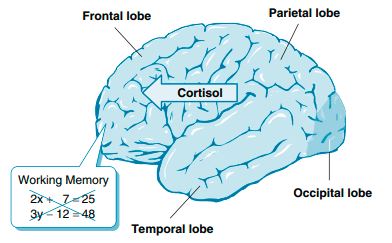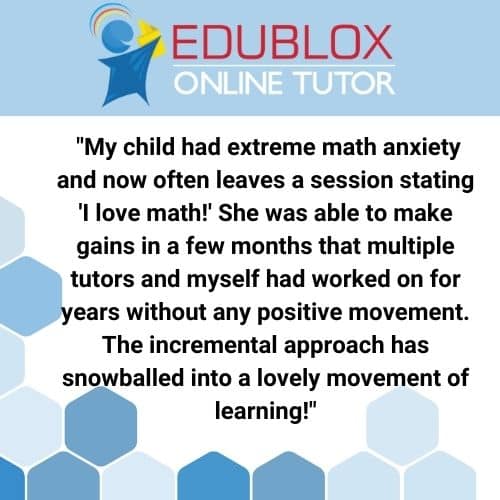
The term dyscalculia — from the Greek ‘dys’ and Latin ‘calculia’ — means to count badly and describes people with severe difficulties with numbers.
Compared to other learning disabilities, such as dyslexia, dyscalculia has received little attention, and the general public’s familiarity with it as a problem is relatively low. Even so, early intervention and treatment are essential to minimize the impact this learning disability can have on a child.
We look at the importance of early intervention, investigate five strategies that should be part of any dyscalculia treatment plan, and how Edublox dyscalculia treatment works.
Table of contents:
- What is dyscalculia?
- Early intervention for dyscalculia is best
- Five strategies for dyscalculia treatment
- How Edublox dyscalculia treatment works
What is dyscalculia?
Dyscalculia is a learning disability in math. It is characterized by impairments in learning basic arithmetic facts, processing numerical quantities, and performing accurate and fluent calculations. These difficulties are below what is expected for the individual’s chronological age and are not caused by poor education or intellectual deficits.
At the behavioral level, children with dyscalculia have difficulties retrieving arithmetic facts from memory. They commonly rely on immature strategies such as finger counting, while their age-matched peers are easily retrieving arithmetic facts from memory..
Early intervention for dyscalculia is best
Dyscalculia may have profound implications for children if no intervention or treatment is provided. Primarily, dyscalculia may impinge on the emotional well-being of students. For example, in a focus group carried out by Bevan and Butterworth (2007) with nine children with dyscalculia, many negative feelings were expressed related to the children’s constant failure in mathematics. The children reported feeling left out, blamed themselves for not knowing how to solve a task, cried, and felt “horrible” and “stupid.”
In the long term, living with dyscalculia can be difficult. Difficulties vary from remembering important telephone numbers and dates to paying the right amount to the cashier when shopping and checking the change. Other tasks presenting problems could be cooking, planning appointments, and being able to use the time available in a day appropriately. Adults with dyscalculia often feel embarrassed when faced with everyday tasks they cannot handle.

Math disabilities may negatively impact job opportunities and prospects in the workplace — even more than literacy difficulties (Bynner & Parsons, 1997). Students with poor numeracy skills tend to leave full-time education at their first chance. As a result, they are more likely to be unemployed, depressed, ill, and arrested. All this illustrates that dyscalculia should be treated at a young age before it has irreversible effects.
Even a slight delay in math can, in a few years, translate into a significant gap between what a child is expected to do and know in math and what they can do. This phenomenon is referred to as the “Matthew Effect,” a term coined by Robert K. Meron in 1968 and referring to Matthew 25:29, which says the rich will get richer, and the poor will get poorer.
Five strategies for dyscalculia treatment
Like other learning disabilities, dyscalculia cannot be treated with medication. Instead, specialized learning strategies are required to treat the disorder. Below are the five most important strategies that need to be applied in any dyscalculia treatment plan:
1. Adhere to fundamental learning principles
Learning is a stratified process. Specific skills need to be mastered first, before it becomes possible to master subsequent skills.
To be a football player, a person must first master the foundational skills, e.g., passing, kicking, and tackling. In the same way, to do math, a child first has to learn the foundational skills of math, like visual perception and visual memory. So, for example, a child who confuses the signs +, -, ÷, and × may have a problem with visual discrimination of forms or visual discrimination of position in space. Likewise, a child with a poor sense of direction (i.e., north, south, east, and west) may have a problem with visual discrimination of position in space, etc.
The second step would be to master mathematical skills, which must be done sequentially. One has to learn to count before it becomes possible to learn to add and subtract. Suppose one tried to teach a child, who had not yet learned to count, to add and subtract. This would be impossible, and no amount of effort would ever succeed in teaching the child these skills. The child must learn to count first, before it becomes possible for him to learn to add and subtract.
The third step would be to ensure that a student catches up on the knowledge aspect of math.
2. Minimize anxiety
It is crucial to minimize anxiety levels as much as possible, as anxiety may be a disability in its own right. For example, anxiety may fill up the working memory space of the brain without allowing the complete and effective processing of numerical tasks (Ashcraft et al., 2000).

Anxiety of any type causes the body to release the hormone cortisol into the bloodstream. Cortisol’s primary function is to refocus the brain on the source of the anxiety and determine what action to take to relieve the stress. As a result, heart rate increases, and other physical worry indicators appear.
Meanwhile, the frontal lobe is no longer interested in learning or processing mathematical operations because it has to deal with what may be a threat to the individual’s safety. As a result, the student cannot focus on the learning task at hand and has to cope with the frustration of inattention. Furthermore, anxious feelings disrupt working memory’s ability to manipulate and retain numbers and numerical expressions (Sousa, 2015).
Letting the student sit up straight is a simple way to minimize anxiety. As part of a study by San Francisco State University researchers, 125 college students were tested to see how well they could perform a simple math task — subtracting 7 from 843 sequentially for 15 seconds — while either slumped over or sitting up straight with shoulders back and relaxed. Fifty-six percent of the students reported finding it easier to perform the math task upright.
For people who are anxious about math, posture makes an enormous difference. The slumped-over position shuts them down, and their brains do not work either. As a result, they cannot think as clearly (Peper et al., 2018).
3. Teach in a multisensory way
Information is taken into the brain through three main channels: visual, auditory, and kinesthetic. Many students with a learning disability are weak in one or more of these channels. Therefore, teaching in a multisensory way, using all three channels simultaneously, will help them as their weaker channels are supported by their stronger ones (Hornigold, 2015).
.

4. Make the most of mistakes
Everyone makes mistakes; they are vital to developing understanding. Unfortunately, constantly making mistakes in math can lead some children to give up. However, research by Jo Boaler and Carol Dweck at Stanford University has shown that synapses grow in the brain when mistakes are made and that there is no growth when the answers are correct. Even if a mistake is not rectified, there will be growth. It is the struggle to get the right answers that fosters growth.
One of the most powerful moves a teacher or parent can make is changing the messages they give about mistakes and wrong answers in mathematics. Teaching students that mistakes are positive has an incredibly liberating effect on them (Boaler, 2016).
5. Repetition is not the enemy
In the 1920s and 1930s, repetition and rote learning came to define bad teaching. Teachers were told that drill-and-practice dulls students’ creativity (Heward, 2003) and that rote learning in math classes is anti-right brain and, therefore, potentially criminal, as it robs all students of the opportunity to develop their human potential (Elliott, 1980).
The phrase “drill and kill” is still used in educational circles, meaning that by drilling the student, you will kill their motivation to learn (Heffernan, 2010).
When properly conducted, however, drill-and-practice is a consistently effective teaching method and should not be slighted as “low level,” and appears to be just as essential to complex and creative intellectual performance as they are to the performance of a virtuoso violinist (Brophy, 1986).
A meta-analysis of 85 academic intervention studies with students with learning disabilities, carried out by Swanson and Sachse-Lee (2000), found that regardless of the practical or theoretical orientation of the study, the largest effect sizes were obtained by interventions that included systematic drill, repetition, practice, and review..
How Edublox dyscalculia treatment works
Edublox offers online treatment to students with mild to severe dyscalculia. Our dyscalculia program aims at the following:

(1.) developing the underlying shortcomings that interfere with math performance, such as poor visuospatial memory, working memory, and logical thinking,
(2.) teaching math skills in a sequential fashion, which may include counting and skip-counting, adding and subtracting, multiplication and division, applying place value, fractions, using money, reading time, etc., as well as
(3.) teaching math knowledge.
We also aim to minimize anxiety and teach math in a multisensory way. We make the most of mistakes, and repetition is not our enemy.
Dyscalculia case studies
Six years of teaching and tutoring failed to help Hannah, who had severe dyscalculia. Her mother discovered the Edublox system and gave it a try. Robyn is a family physician and volunteered to do this testimony because Edublox has changed her daughter’s life.
In this video, Sandy tells about her daughter Amy, who was diagnosed with dyscalculia and dyslexia. Sandy shares how Edublox has helped fill in the holes Amy was missing: working memory, number sense, understanding price tags, and more.
As a result of dyspraxia, Veronica struggled with reading and mathematics. In this video, her father shares how Edublox’s math program has helped to open new worlds for her.
Edublox offers live online tutoring to students with dyscalculia. Our students are in the United States, Canada, Australia, and elsewhere. Book a free consultation to discuss your child’s math learning needs.
Delve deeper
Dyscalculia statistics
There is no general agreement on the precise meaning of the term dyscalculia. Therefore, reports of dyscalculia’s prevalence vary depending on the definition and situation. Research suggests it has the same prevalence as dyslexia (about 6–8% of children), although it is far less widely recognized by parents and educators.
Dyscalculia characteristics, symptoms, and signs
The most generally agreed-upon feature of children with dyscalculia is difficulty learning and remembering arithmetic facts. The second feature of children with dyscalculia is difficulty executing calculation procedures, with immature problem-solving strategies, long solution times, and high error rates. There are many other characteristics, symptoms, and signs.
Dyscalculia types and subtypes
The term developmental dyscalculia is used to distinguish the problem in children and youth from similar problems experienced by adults after severe head injuries or as a result of a stroke. This type of dyscalculia is known as acquired dyscalculia. There are other types and several subtypes.
What causes dyscalculia?
Most problems can only be solved if one knows what causes that particular problem. A viable point of departure would thus be to ask: what causes dyscalculia? We investigate genetic influences, cognitive deficits, mathematical skills, and brain differences.
Authored by Sue du Plessis (B.A. Hons Psychology; B.D.), an educational specialist with 30+ years of experience in learning disabilities.
Medically reviewed by Dr. Zelda Strydom (MBChB).
